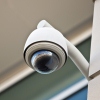
Online Exclusive: Video Security Evolution
Hybrid VMS and NVR systems are quickly gaining popularity. Hybrid recording systems directly connect to existing analog cameras and allow for an easier and more cost effective transition from analog cameras to IP.
- By Brian Carle
- Feb 25, 2013

First we had the VCR, pared with analog cameras. Next came the DVR, also with analog cameras. DVRs were expensive but avoided swapping tapes and all the hassles associated with tape management. Then came IP cameras & VMS software. Higher resolution, Power over Ethernet, remote accessibility and other advantages are driving this shift.
Hybrid VMS and NVR systems are quickly gaining popularity. Hybrid recording systems directly connect to existing analog cameras and allow for an easier and more cost effective transition from analog cameras to IP.
So, what’s next? At almost every major industry event, people are talking about VSaaS, or Video Surveillance as a Service. True VSaaS involves recording video from onsite cameras remotely, to the Cloud. Live video and recordings are accessible from anywhere, and there’s no recorder onsite to manage.
The advantages of a VSaaS deployment vs. a traditional onsite recorder deployment are many.
- (Usually) there is a lower upfront system cost. Because the recording component of the system is provided as a service, it’s typically paid for on a monthly basis. This makes it practical for the system provider to amortize the costs of equipment and installation over the term of the service. This approach can remove the financial ‘sting’ a prospective buyer may feel when deciding on a security solution.
- The system can be expanded easily. Because the user is sharing from a common pool of hardware and infrastructure resources “in the Cloud” it’s simple to increase retention time, or add cameras to the system. Onsite DVR/VMS deployments are designed to handle the number of cameras and storage requirements known at the time of deployment, with limited or no expansion capability.
- Video is inherently remotely accessible. Live video and recordings can be made remotely accessible in a traditional deployment, but it usually involves security tradeoffs or complex network configuration.
- The system is upgraded frequently. It is very easy for a professional administrator to upgrade the recording software for hundreds or thousands of users when it is centrally located and accessible “in the Cloud”. As such, when the user logs in to see their video they’re seeing the latest feature set and functionality. Compared to a traditional system, a security integrator cannot practically upgrade all of their customers every time a software update is available for a camera or recording software. This means the end users would need to keep up with upgrades which don’t happen often enough in practice.
- There is no onsite recording hardware to be stolen, damaged or tampered with. How many small restaurant or retail stores keep both the safe and the DVR in the manager’s office, making it easy to steel assets and the DVR at the same time?
- There are inherently lower service costs with VSaaS. Because the recording system is centrally located and (usually) the cameras are remotely accessible, many service requests do not require a ‘truck roll’ to the customer site. Savings are found in travel time and cost along with faster service.
This is not to say VSaaS is for everyone. Currently, there are limitations to the technology.
Because video is streaming up to the Cloud, the user needs to have an internet connection that can handle the video data. This means the scalability of the system will be limited based on how much bandwidth the user has. Video resolution, frame rate, compression format and scene activity are factors that need to be considered when determining how many cameras can be deployed.
Internet connection reliability is a common concern. If the internet connection goes down, will the user lose their ability to record? In some cases the answer is yes, but other VSaaS technologies support onboard camera storage or an onsite Network Attached Storage device which can take over recording in the event the internet connection goes down.
Because VSaaS is a new technology, available equipment is limited. With traditional deployments, a plethora of cameras, VMS and server hardware exist that can, in many cases, be mixed and matched to provide the right combination of features and functionality. With VSaaS there may be fewer camera choices. Recording and playback features may not be as rich as would be found with products designed to be used in a traditional deployment.
Many of these issues will be resolved in time. As VSaaS products mature, and more products intended for traditional deployment are adapted to VSaaS, equipment selection and feature sets will improve. Internet connections will continue to become faster, allowing for greater scalability.
Keep an eye out for VSaaS technologies because it may be the next stage of evolution in video security.